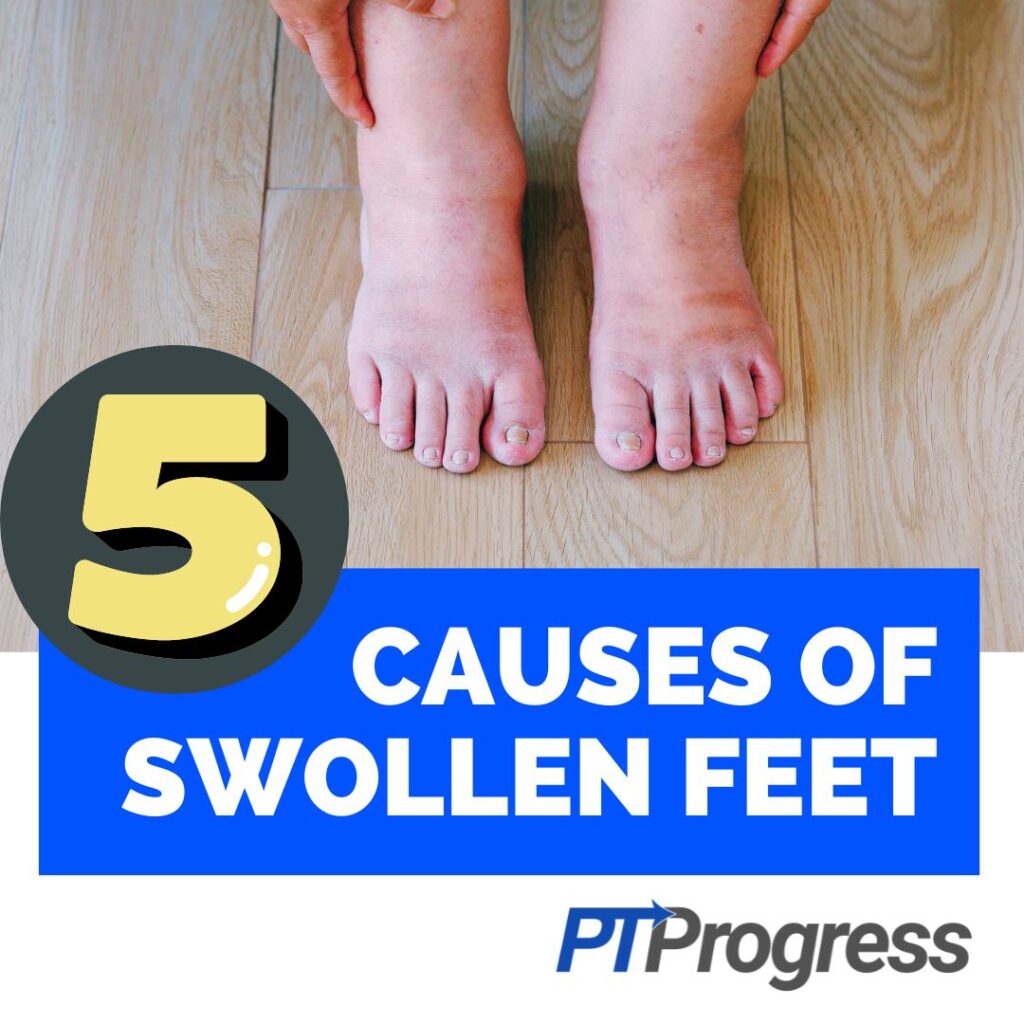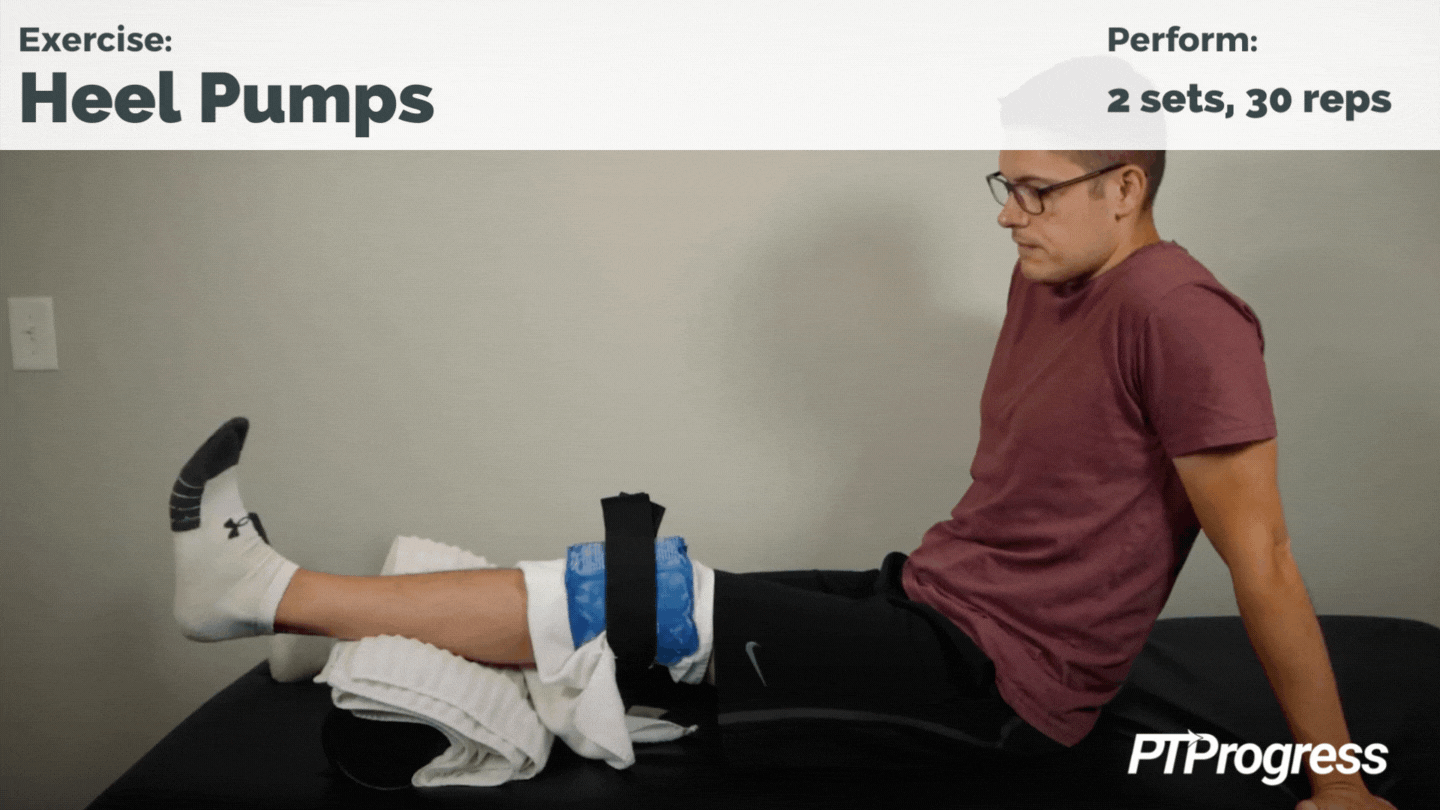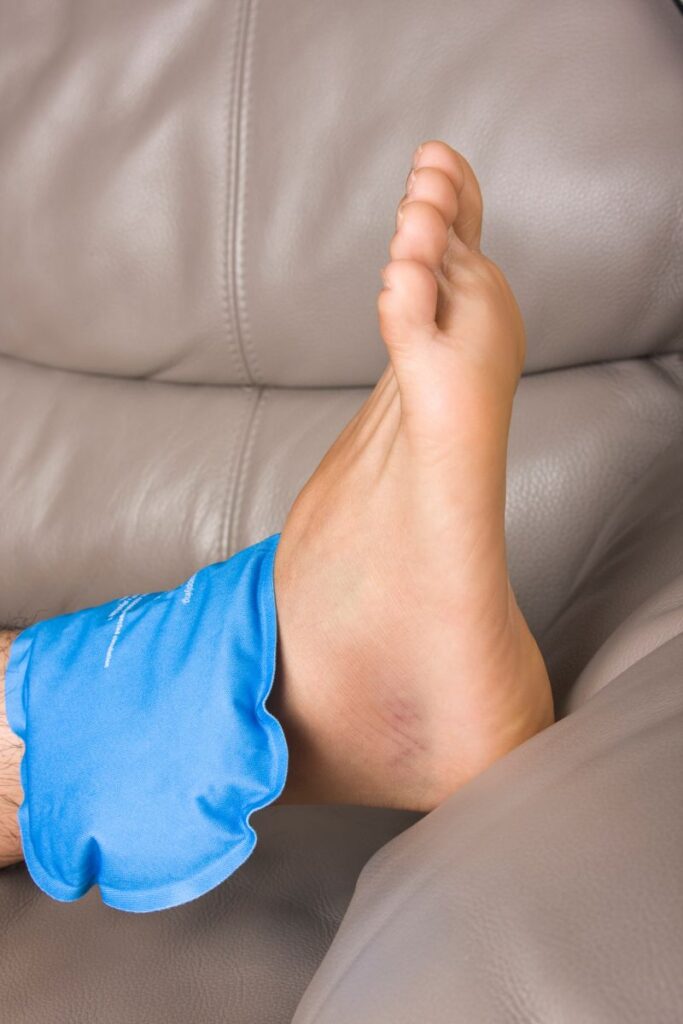
Swollen feet and ankles: it’s something I see almost every day at the clinic as a physical therapist. And although it’s common, swelling can happen for a myriad of reasons, both minor and serious, that make it difficult to diagnose on its own. For that reason, check with your primary care physician if you have a recurring case of swollen feet and ankles.
However, from my work in the clinic I can provide the 5 top reasons why your feet and ankles may be swelling. Keep reading to learn more!
Signs of Swelling
The medical term for swelling is “edema,” and it’s the result of fluid accumulating in your body’s tissues. Although edema can occur throughout the body, the feet and ankles are among the most common locations.
If you have edema in your ankles, they may appear abnormally puffy, and the skin around your ankles may look stretched and shiny. Try pressing on the puffy skin for a few seconds; if it leaves a dimple or indentation, then you probably have edema.
Although edema itself isn’t a dangerous condition, it can lead to problems such as difficulty walking and decreased circulation in the feet. More importantly, edema may indicate a serious concern that you’ll need to promptly diagnose and treat.
Here are 5 of the most common reasons for swollen feet and ankles.
Reason #1: Post-surgical swelling or blood clots
After surgery, you may experience an increase in swelling in the lower extremities. Although it’s necessary to rest after surgery, too much inactivity can lead to a buildup of fluid, making it more painful or uncomfortable to move as you recover.
If you see a PT meanwhile, they’ll likely tell you to practice ankle pumps. This easy exercise helps promote blood flow in the feet and ankles. Simply pointing and flexing your foot activates the muscles in your lower legs and works like a sump pump to draw fluid back up towards the heart. With less fluid in the way, you’ll see a reduction in swelling and an increase in circulation.

Following a surgery, you may also become more prone to blood clots. If your blood flow thickens or slows abnormally, then a clot may form, preventing fluid in the body from draining properly. A blood clot lodged deep in your veins is called DVT, or deep vein thrombosis, which can become much more serious.
To prevent a postoperative complication, keep aware of the signs of a blood clot: shortness of breath, lightheadedness, and tenderness or soreness in your lower extremities. Practicing ankle pumps will be especially helpful for increasing your blood circulation while decreasing your risk of blood clots.
Reason #2: Foot or ankle injury
Whether you’ve sprained your ankle or broken your foot, there’s a good chance you’ll experience increased swelling. This time, the swelling is due to an increase in white blood cells to the site of the injury, which is necessary for healing.
However, after the initial injury, the swelling can get in the way of your recovery. So once you’re off your ankle and treating your injury, the next thing to do is bring the swelling down with ice and elevation.

First, put your feet up; it’s one of the easiest, fastest ways to reduce swelling. Next, apply ice, which helps decrease swelling by restricting your blood vessels and reducing the volume of blood that your body can dump at the site of the injury.
For best results, apply an ice pack that conforms to your ankle, as opposed to ice cubes in a bag. Ice your ankle for no more than 20 minutes to avoid tissue damage, and always ensure there’s a protective barrier (like a padding or towel) between your skin and the ice pack.
Many ice packs come with a compression bandage, which may help reduce pain and swelling. However, after the initial ice and elevation, check with your PT or doctor to see if the injury requires further intervention.
Reason #3: Infection
Another possible reason for your swollen ankles is that you’re fighting an infection in your lower extremities. In response to pathogens, your body produces white blood cells en masse, which help curb the infection but can also accumulate in the feet and ankles.
You may not realize you have an infection or an injury prone to infection. People with diabetes, for example, have decreased sensation in their lower legs and feet and may not notice their open wound. If you have diabetes or otherwise impaired sensation in your lower extremities, make sure you visually inspect your feet and lower legs for any changes, such as blisters or skin irritation, that can lead to an infection.
Once your infection has been contained and treated, the swelling should go down. However, a routine of elevation, compression, and light physical therapy may be prescribed to help reduce any residual edema.
Reason #4: Lymphedema
If your ankles are chronically swollen—meaning, not just once after an injury, but frequently and for long periods of time—then you may have a more serious chronic condition.
For example, lymphedema is a buildup of lymph, a fluid that contains water, salt, white blood cells, and other proteins. Damage to your lymph vessels or lymph nodes can lead to a disruption in lymphatic flow and lead to this excess buildup, or “lymph” edema.
You may experience lymphedema after cancer surgery or radiation therapy, which can destroy lymph tissue and lead to a buildup in lymphatic fluid. Leukemia can also precipitate an increase in white blood cells and lymphedema symptoms.
Although the reasons for lymphedema require expert care, you can help abate the swelling symptoms at home. Your PT or physician may recommend wearing compression garments or prescribe a medical-grade lymphedema pump to reduce the flow of lymph to your feet and ankles.
Reason #5: Heart disease or Kidney Disease
Although the heart and kidneys serve very different functions, they both influence the circulation of fluid in the body. The heart is responsible for pumping blood to and from your lower extremities. But if your heart is failing or weak, then the rate of blood flow will decrease, circulation will falter, and blood will pool in your body’s tissues.
Heart disease can also affect your kidneys, which rely on regular blood flow to filter sodium and waste products from the body. Congestive heart failure can interfere with this process and cause a buildup of fluid in the feet and ankles.
With renal disease, your kidneys will struggle to eliminate waste from your bloodstream. As a result, excess sodium and fluid will accumulate at the feet and ankles, and if you sit and stand for most of the day, gravity will keep it there.
To help drive the fluid away from your lower extremities, try performing ankle pumps a few times a day. Your doctor may recommend light physical activity or physical therapy to help strengthen your heart and combat other issues, such as weight gain or high blood pressure. Otherwise, wearing compression garments can also reduce edema and encourage better blood flow.
It’s important to monitor your symptoms if your doctor has diagnosed you with heart or kidney disease. Be sure to inform your doctor of other issues you may experience, such as shortness of breath, chest pain, or pressure in your chest.
Other Causes for Edema
Edema is an outward sign the body uses to indicate something is off. Injuries, infections, and chronic diseases are just a few of the many reasons why fluid may be pooling in your lower legs.
Other causes include lifestyle factors, such as the medications you take, the food you eat, and the amount of activity you do each day. For example, a diet heavy in salt can overload the kidneys and cause a backup of fluid, while sitting or standing for too long draws blood down to the feet and ankles until they swell up.
In summary, if your feet and ankles are swollen, keep in mind the many factors that could be contributing to your edema. Make sure you consult your doctor or PT, especially if the swelling increases or is accompanied by other concerning symptoms.

